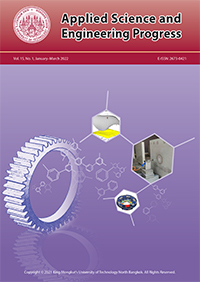A Modified Strain-displacement Method for High Accuracy 8-Node Solid Finite Element
Main Article Content
Abstract
Higher-order three-dimensional solid elements are widely used for machine design and structural analyses. Although higher-order solid elements offer higher accuracy, the assembly routines often consume large amount of computational time and memory usage. In contrast, lower-order solid elements such as an 8-nod are simpler in programming implementation and consume less computational resources. However, they can produce problems of locking phenomena e.g. membrane and shear locking. Moreover, in a three-dimensional analysis using continuum solid elements, it is necessary to consider the stresses in the through-thickness direction, for example, in layered soil and foundation. This research aims to develop a modified strain-displacement finite element formulation that eliminates locking problems and generally applicable to both thick and thin threedimensional structures. The proposed formulation is based on the key concept of energy equivalence mapped between the global and natural curvilinear coordinates. The advantage of the proposed method is the ability to select a set of chosen strain functions that can be defined arbitrarily on the natural curvilinear coordinates.
Article Details
References
[2] T. H. H. Pian and K. Sumihara, “Rational approach for assumed stress finite elements,” International Journal for Numerical Methods in Engineering, vol. 20, pp. 1685–1695, 1984.
[3] J. C. Simo and M. S. Rifai, “A class of assumed strain methods and the method of incompatible modes,” International Journal for Numerical Methods in Engineering, vol. 29, pp. 1595–1638, 1990.
[4] L. Tang, W. Chen, and Y. Liu, “String net function application and quasi-conforming technique,” in Hybrid and Mixed Finite Element Methods. New York: Wiley, 1983.
[5] Y. Ko and K. J. Bathe, “A new 8-node element for analysis of three-dimensional solids,” Computer and Structures, vol. 202, pp. 85–104, 2018.
[6] Y. Wang and G. Shi, “Simple and accurate eightnode and six-node solid-shell elements with explicit element stiffness matrix based on quasiconforming element technique,” International Journal of Applied Mechanics, vol. 9, no. 1, 2017, doi: 10.1142/S1758825117500120.
[7] M. A. Crisfield, Nonlinear Finite Element Analysis of Solids and Structures Vol.1. Chichester, England: John Wiley & Sons, 1991.
[8] M. A. Crisfield, Nonlinear Finite Element Analysis of Solids and Structures Vol.2. Chichester, England: John Wiley & Sons, 1997.
[9] S. Pornpeerakeat and K. Sriboonma, “Developement of the high accuracy three-dimensional solid element for the finite element method,” Faculty of Technical Education, King Mongkut’s University of Technology North Bangkok, 2015.
[10] GiD, “Pre-post processor Software, International Center for Numerical Methods in Engineering,” (2020). [Online]. Available: http://gid.cimne.upc.es/
[11] K. D. Kim, G. R. Lomboy, and G. Z. Voyiadjis, “A 4-node assumed strain quasi-conforming shell element with 6 degree of freedom,” International Journal for Numerical Methods in Engineering, vol. 58, pp. 2177–2200, 2003.
[12] M. Mostafa, M. V. Sivaselvan, and C. A. Felippa, “A solid-shell corotational element based on ANDES, ANS and EAS for geometrically nonlinear structural analysis,” International Journal for Numerical Methods in Engineering, vol. 95, pp. 145– 180, 2013
[13] J. C. Simo, D. D. Fox, and M. S. Rifai, “On stress resultant geometrically exact shell model, Part II: The linear theory; Computational aspects,” Computer Methods in Applied Mechanics and Engineering, vol. 7, pp. 53–92, 1989.
[14] R. H. MacNeal and R. L. Harder, “A proposed standard set of problems to test the finite element accuracy,” Finite Elements in Analysis and Design, vol. 1, pp. 3–20, 1985.


